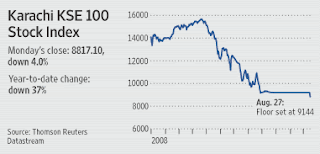How Far Will Karachi Stocks Fall?

Monday's removal of an arbitrary floor of 9144 points on KSE-100 imposed Aug 27 has sent Karachi shares plunging 16.21% in the first four days of trading, with KSE-100 closing at 7,785.26 points on Thursday.
The government and the exchange had hoped to be able to put together a 20 billion rupee ($255 million) stabilization fund to support prices once the floor was removed. However, some participating institutions balked at putting money into a falling market. Also, the International Monetary Fund, which recently agreed to advance Pakistan $7.6 billion to help stabilize its economy, is against using government funds to bolster share prices, reports the Wall Street Journal.
"Foreign portfolio investors who may have faced a liquidity crunch due to global events will offload their holdings in Pakistan," said Farhan Mahmood, a research analyst at JS Global Securities.
The trading volume at KSE has surged more than 50 times since Monday to over 50 million share a day. It had been less than a million shares a day average since Aug 27, 2008.
The 49% drop in KSE-100 this year still compares favorably with Bombay's Sensex index fall of 55% so far in 2008. Since the KSE's movement of shares and the index is still restricted to a daily limit of 5% either way, it is likely to see further volatility in the remaining two weeks of this year, unless Pakistan's government is able to restore some confidence in the economy after the IMF bailout. If the KSE does continue its decline, however, it could create an opportunity for smart investors to pick up some good, healthy Pakistani blue chip companies' shares at deep discounts.



Comments
In May this year, Pakistan's sovereign debt rating was lowered to B2 from B1, one level below Turkmenistan and Jamaica. The ranking on locally-issued debt was also reduced to B2. With further rating cuts, Pakistan ended up with junk ratings of CCC, far below the investment grade rating of B1 in 2007 under Musharraf-Aziz administration.